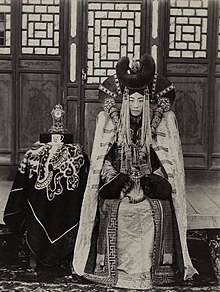Khalkha Mongols
The two original major Khalkha groups were ruled by the direct male line descendants of Dayan Khan.The Baarin, Khongirad, Jaruud, Bayaud and the O'zeed (Ujeed) became Dayan Khan's fifth son Achibolod's subjects, thus formed the Southern Five Halhs.Seven northern Khalkha otogs: 1) Jalairs, Olkhonud; 2) Besut, Iljigin; 3) Gorlos, Keregut; 4) Khuree, Khoroo, Tsookhor; 5) Khukhuid, Khatagin; 6) Tanghut, Sartuul; 7) Uriankhai[4] became Dayan Khan's youngest (could be third) son Geresenje's (Mongolian: Гэрсэне Жалайр Хан) subjects.In Mongolian historical sources such as Erdeniin Erih ("The Beads of Jewel") it clearly stated how the Khalkha Tumen was created and where these people resided at the time of its creation.The statement goes as follows: It is also believed that the Southern Khalkha who now reside in Inner Mongolia were moved south from its original territory Khangai Mountains.To commemorate and signify their origin, every new lunar year all southern Khalkhas perform special Khangai Mountain worshipping ceremonies and they face northwest and pray.Some scholars consider that the Halh had a close connection with the Five Ulus of the Left Wing of the former Yuan dynasty, which was led by the five powerful tribes of Jalayir, Onggirat, Ikires, Uruud and Mangghud.They preserved their independence until they had to seek help from the Kangxi Emperor of the Manchu-led Qing dynasty against the Zungar leader Galdan in 1688.The Halh Mongols in Qinghai, China and the ones among the Buryats in Russia were subjects to Khalkha's Tsogtu Khan and his sons.[8] Today the Oirats of Gushi Khan is also known as the "Upper Mongols" or the "ДЭЭД МОНГОЛ", and they still reside in Qinghai forming 21 banners.The remnants of Tsogtu Khong Taiji's Halhs form only one banner and are known as the "Lower Mongols" or "ДООД МОНГОЛ".Starting 1628 with the Russian Conquest and Buriat Migration, the Selenge Valley, as before, was inhabited by Mongol clans under the rule of the Khalkha khans.At the same time, however, the Khoris along the Uda River in 1647 surrendered as a block to the Russians to escape paying tribute to the Khalkhas.These groups are: Descendants of Okhin Taij (grandson of Khalkha's Tsogtu Khan); Khatagin; Atagan; Ashabagad; Sartuul; Tavnanguud; Yungsiebu; O'zeed; Uuld; Tsongool.


Khalkhin GolKhalkha MongolianNorthern YuanMongoliaHalh MongolianBuddhismMongolian ShamanismEastern Orthodox ChurchProtestantismMongolBuryatsKhotgoidOiratsMongolianMongolsChaharsBorjiginDzungarKhorchinsDayan KhanBaarinKhongiradJaruudBayaudJalairsOlkhonudIljiginGorlosKhataginTanghutSartuulUriankhaiKhotogoidsGenghis KhanDZUNGARKHANATEKHOSHUTKHANATEQINGDYNASTYMUGHALEMPIREMADURAINAYAKSCHAM-PASAFAVIDEMPIREOTTOMANEMPIREKHIVAKHANATEBUKHARAKHANATEKAZAKH KHANATETSARDOM OF RUSSIACRIMEANKHANATEKALMYKKHANATEJO-SEONAYUT-THAYADAIVIETAltishahrKhalkhyn GolErdene Zuu MonasteryAbtai Sain KhanInner MongoliaMongolian scriptKhangai MountainstümenManchusYuan dynastyOnggiratMangghudd'AnvilleJesuitsGreater KhinganEight BannersTögs-Ochiryn NamnansürenOyiradTüsheet KhanZasagt KhanSetsen KhanKangxi EmperorManchuQing dynastyZungarGaldanYongzheng EmperorSain Noyon KhanMongolian independence movementGenepilQinghaiChoghtu Khong TayijiLigdan KhanDalai LamasmallpoxUpper MongolsByambyn RenchinEthnic groups of ChinaSino-TibetanSiniticHan ChinesesubgroupsCaijiaChuanqingLongjiaWaxiangLolo-BurmeseAchangKucongLaomianLaopinQixingminQiangicGyalrongTibeticTibetansSherpaJingpoDerungAustroasiaticVietnameseTa'angAustronesianGaoshanFilipinoUtsulsHmong-MienMongolicDongxiangMonguorYugursEasternHamniganKangjiaKhatso

